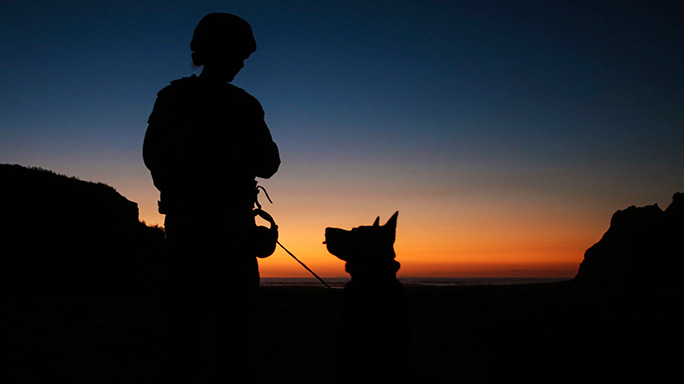The following is a release from Lance Cpl. Caitlin Bevel, I Marine Expeditionary Force:
The roar of an engine, the breaking of waves against a bulkhead and the jarring shift from the rocking sea to solid land could disorient any Marine, but for military working dog handlers, keeping their canine partners focused presents an even greater challenge.
To overcome this obstacle, Marines constantly train to improve proficiency with the weapons and equipment needed for their specific job fields. For the Marine dog teams with 1st Law Enforcement Battalion, I Marine Expeditionary Force Headquarters Group, this includes any and every vehicle that could be used to transport them to where they are needed.
Advertisement — Continue Reading Below
On Oct. 21, 2015, 1st LEB Marine working dog teams used Landing Craft Air Cushions to perform amphibious landings and search for simulated explosives on a beach aboard Marine Corps Base Camp Pendleton, Calif.
“The LCAC is basically a hover craft that goes over water and lands on the beach,” said Cpl. Suzette Clemans, a military working dog handler with 1st LEB. “It’s good training because the dog goes from being on a vessel to working right onto the beach.”
Amphibious landings often require Marines to adjust quickly from waiting in the vehicle to the explosive activity of the mission on dry land. This becomes more complex when dogs are involved.
Advertisement — Continue Reading Below
“Some dogs can get nervous inside tight spaces, the waves might make them feel sick or uncomfortable, and getting on and off the vessel can be stressful for them,” said Clemans, an Orlando native partnered with Denny, a Belgian Malinois patrol explosive detection dog.
The LCAC is large enough to hold multiple trucks or pieces of large equipment, but passengers like the dog teams ride in a compact room with only two small windows.
“When you first get off of something like that it’s up to you to get the dog settled,” said Gunnery Sgt. Chris Willingham, the Kennel Master for 1st LEB. “It’s very important for handlers to understand their dog’s capabilities and limitations.”
Advertisement — Continue Reading Below
The LCAC is one of the few vessels where the dogs experience a change of terrain without being able to explore or see what is happening around them. They boarded the vessel in one area and came ashore somewhere completely different where they immediately searched for possible explosives.
“Anything you can expose a dog team to prepares them for future unknowns,” said Willingham. “What you don’t want is to have your dog in a bland situation all the time where they know exactly what’s going on and there’s nothing with shock value or extra variables thrown in.”
The dog teams train with everything from trucks to helicopters to make sure they are ready for whatever situations they might face, said Willingham, a Tuscaloosa, Alabama, native who has been with the program for 15 years.
Advertisement — Continue Reading Below
“You can’t plan for everything, but we always try to think outside the box to expose our dogs to different sites, sounds and smells,” said Willingham. “If we identify any issues, we want it to be during training rather than combat.”
Willingham said he could not be more proud. The handlers brought their partners’ attention back to the mission immediately and conducted off leash searches of roadways and vegetation where they gave positive responses to odors planted at the scene.
“Being part of the military working dog program, you are part of a very special legacy,” said Willingham. “It doesn’t matter what branch of service you’re in, if you’re K-9 then you’re K-9 and that’s something we take a lot of pride in.”
Advertisement — Continue Reading Below
Clemans said that she has been with Denny for a year and a half, since she joined the program, and it gives her confidence to know he has her back. The dogs and their handlers support the amphibious and expeditionary nature of the Marine Air Ground Task Force by enhancing the security environment.
“We are definitely ready,” said Clemans. “Any time, any place, you name it and we’re there.”
























